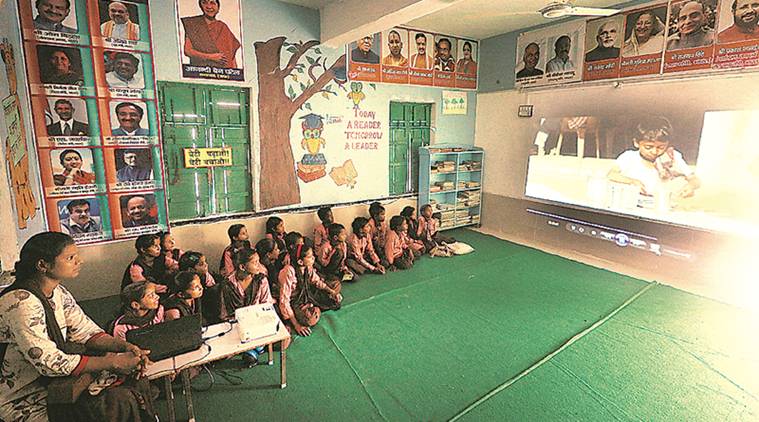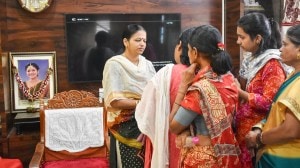- India
- International
In Bahraich, when children don’t go to school, teacher comes home
The school now has 10 classrooms, including a ‘smart classroom’, that overlook a small grassy lawn with plants arranged neatly in flower beds.
 At Yadavpur primary school in Bahraich district of Uttar Pradesh. Vishal Srivastav
At Yadavpur primary school in Bahraich district of Uttar Pradesh. Vishal Srivastav
At 7.45 am on a Tuesday morning, Devanand, a Class 3 student of the government primary school at Yadavpur village in Uttar Pradesh’s Bahraich district, walks in with measured steps. The morning assembly is on and he is late by 15 minutes. But then, just as he had feared, principal Rajesh Kumar Pandey’s eagle eye swoops down on him. “Go, stand in line and be on time from tomorrow. The school starts at 7.30 am. Anyone who comes in late will not be allowed,” says Pandey, loud enough for the other latecomers to stop in their tracks.
After the assembly, as the students head back to their classes, Pandey, 46, says he has to constantly play the disciplinarian to ensure the school doesn’t slip into the state it was in when he joined as a teacher in 2011. “I was the only teacher for the primary classes, and there was one teacher for the upper primary school. Students barely came to school, and even if they did, nobody told them that it was important that they reached on time. Of the 171 students on the rolls, only 70-80 students would attend school. Besides, there was no boundary wall, no gate. The villagers used the school compound as a thoroughfare to take their cattle to the fields on the other side,” he says.
Today, though, the total enrolment in the primary and upper primary sections (Class 1 to 8) has touched a high of 532, of whom 418 students were present on Tuesday. “We also have three teachers each for the primary and upper primary schools. Though we need more teachers, a beginning has been made,” Pandey adds.
Shahana Begum, headmistress of the upper primary school that shares the compound with the primary school, says, “The attendance has shot up significantly due to Pandeyji’s efforts. Other teachers have also pitched in, but most of the credit goes to Pandeyji. He is the one who goes to villages and encourages parents to send their children to school.”
The school now has 10 classrooms, including a ‘smart classroom’, that overlook a small grassy lawn with plants arranged neatly in flower beds. “Teachers and the students pitch in to look after the plants,” says Swati Singh, 35, a teacher in the primary school.

In the ‘smart classroom’, Hamida Bano and Kajal Maurya, students of Class 5, are setting up today’s e-classroom. As she peers into the laptop that’s connected to a projector, Hamida says, “We are learning geography today — states, Union Territories and their capitals. Since we can operate the laptop, we are setting it up before the other students arrive.”
Swati Singh says much of the change the school has witnessed has been through donations and contributions. “We were lucky to get the projector. After a visit by Chief Veterinary Officer Dr Balwant Singh, he donated it to us as a goodwill gesture,” she says. Teachers do their bit too. “We contribute around 10 per cent of our salary to improve the school. We contribute depending on what is required. For instance, I bought furniture worth Rs 4,000 in January. Other teachers pitch in with other things. We are now thinking of buying another laptop,” says Swati, adding, “We have been making these contributions for 4-5 years now.”
Nizamuddin, 52, a doctor in the village, says the gram panchayat of Yadavpur did not have a graduate until 2015, but now at least 7-8 youngsters from the village study in degree colleges in the district. “Pandey and the other teachers come to the village in the evenings to talk to us. That is something that has never happened before. And because the school building now looks like a school, parents also want to send their children there. Earlier, it was like a khandhar (ruins),” he says.
Barasati, 45, a daily-wage labourer whose son Aleem is a Class 1 student in the school, says his only hope is that the school continues to function the way it has been for the last few years. “We all know how important education is. I would want my son to at least finish his Class 12, so he can read signboards.” Sitting near him at a tea shop in the village, Abdul Khalid, whose son is in Class 7, says, “When the children don’t go to school, the teacher comes home.”
Bahraich Basic Shiksha Adhikari (BSA) Shyam Kishore Tiwari says the Yadavpur school has improved because of the efforts of the teachers and the principal. “We are working on improving the school further, but the work done in this school is an example for the education sector in the state and the country. In eight years, the teachers have made the school a model school,” he says.
Apr 26: Latest News
- 01
- 02
- 03
- 04
- 05







































